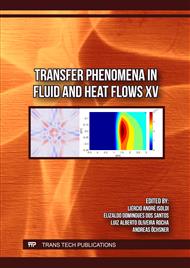[1]
Garcia-Navarro et al., in: The shallow water equations and their application to realistic cases, Environmental Fluid Mechanics, (2019).
Google Scholar
[2]
V. Caleffi, A. Valiani, A. Zanni in: Finite Volume Method for Simulating Extreme Flood Events in Natural Channels, Journal of Hydraulic Research, 41(2), 167-177 (2003).
DOI: 10.1080/00221680309499959
Google Scholar
[3]
J. N. Eddy, in : An Introduction to the Finite Element Method, Third edition, McGraw-Hill, Paris (2006).
Google Scholar
[4]
V. Ruas in :Hermite finite elements for second order boundary value problems with sharp gradient discontinuities, Journal of Computational and Applied Mathematics, 246, 234-242 (2013).
DOI: 10.1016/j.cam.2012.08.027
Google Scholar
[5]
R. Kolman, M. Okrouhlík, A. Berezovski, D. Gabriel, J. Kopačka, J. Plešek in :B-spline based finite element method in one-dimensional discontinuous elastic wave propagation, Applied Mathematical Modelling, 46, 382-395 (2017).[6] C. Grossmann; H. Roos; M. Stynes in Numerical Treatment of Partial Differential Equations,Springer Science AND Business Media, (2007).
DOI: 10.1016/j.apm.2017.01.077
Google Scholar
[7]
S. Kocaman, H. Ozmen-Cagatay in: Investigation of dam-break induced shock waves impact on a vertical wall, Journal of Hydrology, 525, 1-12 (2015).
DOI: 10.1016/j.jhydrol.2015.03.040
Google Scholar
[8]
C. KUHBACHER. Shallow Water: Derivation and Applications. Alemanha: 2009.
Google Scholar
[9]
W.D. Guo, J.S. Lai, G.F. Lin, F.Z. Lee, Y.C. Tan in : Finite-volume multi-stage scheme for advection-diffusion modeling in shallow water flows, Journal of Mechanics, 27, 415-430, (2011).
DOI: 10.1017/jmech.2011.44
Google Scholar
[10]
C. S. Silva in: Inundações em Pelotas/RS: o uso de geoprocessamento no planejamento paisagístico e ambiental, Dissertação de Mestrado, Programa de Pós-Graduação em Arquitetura e Urbanismo, Faculdade de Arquitetura e Urbanismo, Universidade Federal de Santa Catarina, Florianópolis, Brasil, 196 páginas (2007).
DOI: 10.17127/got/2021.22.008
Google Scholar
[11]
J.N. Reddy in: Introduction to the Finite Element Method, McGraw-Hill Science/Engineering/Math, Reino Unido (2005).
Google Scholar
[12]
T. J. R. Hughes, D. W. K. Liu, T. K. Zimmermann in: The Finite Element Method: Linear Static and Dynamic Finite Element Analysis, Courier Corporation, Reino Unido (2012).
Google Scholar
[13]
R. L. Burden, J. D. Faires in: Análise Numérica. Cengage Learning (2008), Brasil.
Google Scholar



